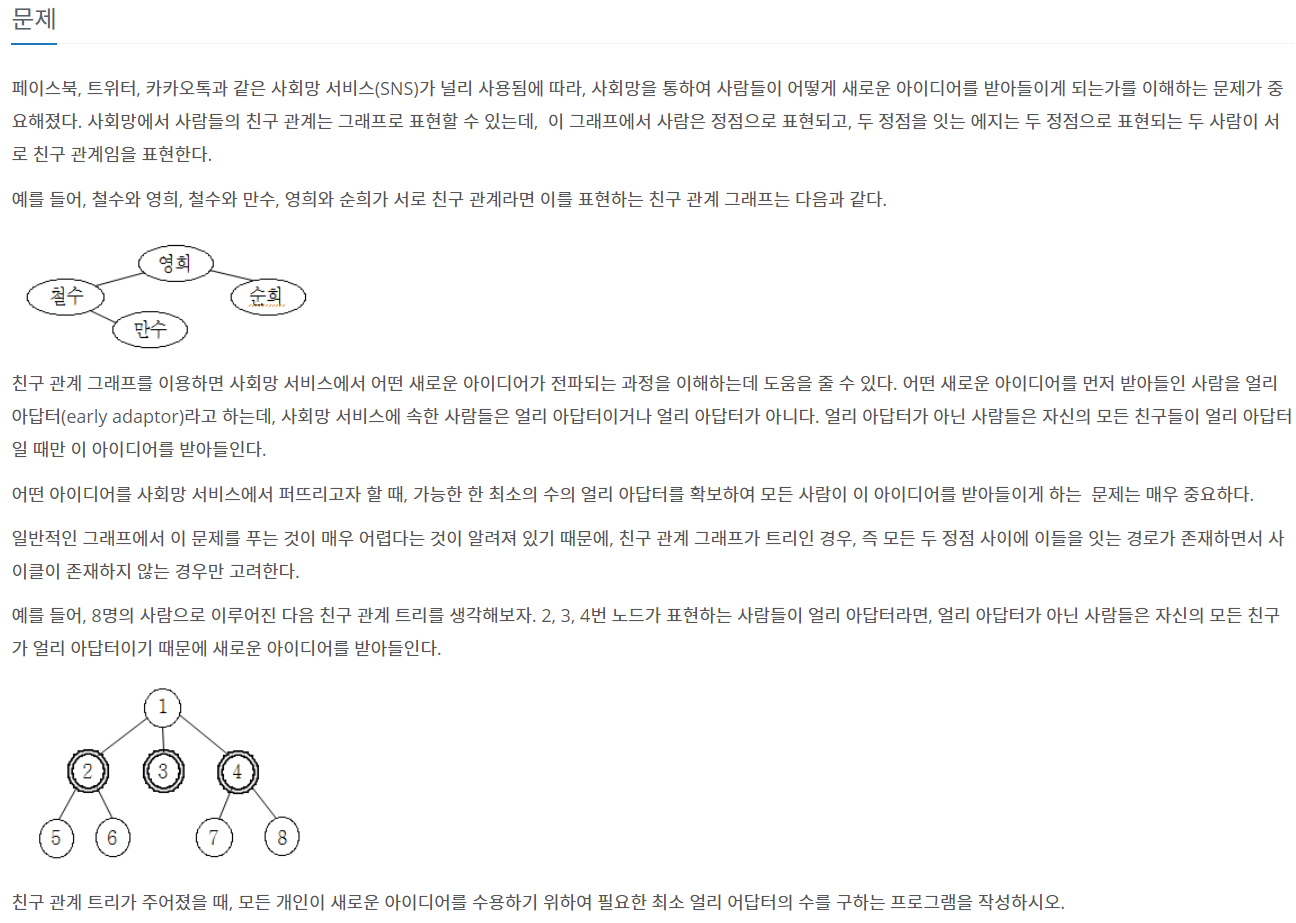
다른 사람 풀이
import sys
from sys import stdin, setrecursionlimit
setrecursionlimit(10 ** 9)
readline = stdin.readline
N = int(input())
tree = [[] for _ in range(N+1)]
dp = [[0, 1] for _ in range(N+1)] # 0: 노드가 얼리어답터가 아닐때, 1: 얼리어답터 일 때
visited = [False] * (N+1)
for _ in range(N-1):
u, v = map(int, sys.stdin.readline().split())
tree[u].append(v)
tree[v].append(u)
def dfs(cur):
visited[cur] = True
for child in tree[cur]:
if not visited[child]:
dfs(child)
# 현재 노드가 얼리어답터가 아니면 자식은 무조건 얼리어답터여야 한다.
dp[cur][0] += dp[child][1]
# 현재 노드가 얼리어답터일 경우 자식 노드는 얼리어답터여도 되고 아니여도 된다.
dp[cur][1] += min(dp[child])
dfs(1)
print(min(dp[1]))트리에서 dp를 활용하는 문제는 예전에 카카오에 나온적이 있다고 들었는데, 이번 기회에 풀어보게 되었다. 이 문제는 '최대 독립 집합' 개념과 맞닿아 있다.
어떤 그래프 G의 정점들의 집합을 S라고 하자. 이러한 S의 부분 집합 S`을 선택하였을 때, 각 정점들이 인접하지 않는다면 이를 Independent Set(독립 집합) 이라고 부른다. 이 때, 최대로의 정점을 뽑아서 Independent Set을 만드는 것을 Maximum Independent Set이라고 한다.
트리의 각 노드에는 두 가지 경우의 수가 있는데, 하나는 그 노드가 얼리어답터가 되는 경우이고, 다른 하나는 얼리어답터가 안되는 경우이다.
그 노드가 얼리어답터라면, 자식노드는 얼리어답터여도 되고, 아니여도 된다. 반대로 그 노드가 얼리어답터가 아니라면, 자식 노드는 모두 얼리어답터여야 한다.
자바 버전 풀이
import java.io.BufferedReader;
import java.io.IOException;
import java.io.InputStreamReader;
import java.util.ArrayList;
import java.util.Arrays;
import java.util.List;
public class baekjoon_2533 {
static int N;
static List<Integer>[] graph;
static boolean[] visited;
static int[][] dp; //노드가 얼리어답터 일때 개수
public static void main(String[] args) throws IOException {
BufferedReader br = new BufferedReader(new InputStreamReader(System.in));
N = Integer.parseInt(br.readLine());
graph = new ArrayList[N+1];
visited = new boolean[N + 1];
dp = new int[N + 1][2];
for (int i = 1; i <= N; i++) {
dp[i][1] = 1; //자신이 얼리어답터면 1개는 무조건 얼리어답터다
}
for (int i = 0; i <= N; i++) {
graph[i] = new ArrayList<>();
}
for (int i = 0; i < N-1; i++) {
String[] inputs = br.readLine().split(" ");
int A = Integer.parseInt(inputs[0]);
int B = Integer.parseInt(inputs[1]);
graph[A].add(B);
graph[B].add(A);
}
dfs(1);
System.out.println(Math.min(dp[1][0], dp[1][1]));
}
private static void dfs(int curNode) {
visited[curNode] = true;
for (int child : graph[curNode]) {
if (!visited[child]) {
dfs(child);
//현재 노드가 얼리어답터가 아니면 자식은 무조건 얼리어답터
dp[curNode][0] += dp[child][1];
//현재 노드가 얼리어답터면 자식 노드는 둘 중 최소
dp[curNode][1] += Math.min(dp[child][0], dp[child][1]);
}
}
}
}트리 DP 정석 풀이
import java.io.BufferedReader;
import java.io.IOException;
import java.io.InputStreamReader;
import java.util.ArrayList;
import java.util.List;
import java.util.Scanner;
public class Main {
public static List<Integer>[] childs = new ArrayList[1000001];
public static int childCount[] = new int[1000001];
public static int cache[][] = new int[1000001][2];
static{
for (int i = 0; i < 1000001; i++) {
childs[i] = new ArrayList<>();
for (int j = 0; j < 2; j++) {
cache[i][j] = -1;
}
}
}
public static int N;
public static void main(String[] args){
Scanner sca = new Scanner(System.in);
N = sca.nextInt();
for (int i = 0; i < N-1; i++) {
int pa = sca.nextInt();
int ch = sca.nextInt();
childs[pa].add(ch);
childs[ch].add(pa);
}
dfs(1, -1);
System.out.println(Math.min(getMinEarly(1, 0, -1), getMinEarly(1, 1, -1)));
System.out.println();
}
public static int dfs(int node, int parent){
int sum = 1;
for (int i = 0; i < childs[node].size(); i++) {
if(childs[node].get(i) == parent)
continue;
sum += dfs(childs[node].get(i), node);
}
return childCount[node] = sum;
}
public static int getMinEarly(int root, int onOff, int parent){
// 탈출조건
if(childCount[root] == 1){
return onOff == 1 ? 1 : 0;
}
if(cache[root][onOff] != -1)
return cache[root][onOff];
// root가 켜져 있을 때
if(onOff == 1){
int sum = 1;
for (int i = 0; i < childs[root].size(); i++) {
int child = childs[root].get(i);
if(child == parent)
continue;
sum += Math.min(getMinEarly(child, 1, root), getMinEarly(child, 0, root));
}
return cache[root][onOff] = sum;
}
// root가 꺼져 있을 때
int sum = 0;
for (int i = 0; i < childs[root].size(); i++) {
int child = childs[root].get(i);
if(child == parent)
continue;
sum += getMinEarly(child, 1, root);
}
return cache[root][onOff] = sum;
}
}